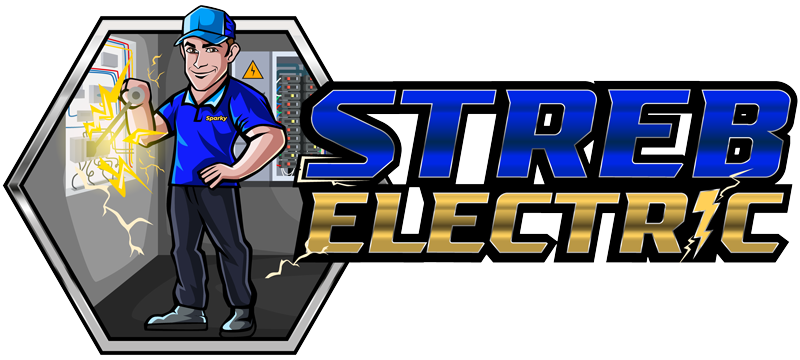You flick on a light, plug in your computer, or start the dishwasher. Suddenly, a breaker trips. It’s frustrating, and it means something in your home’s electrical system is struggling to keep up.
Across Ohio, the housing stock is aging. In fact, half of Ohio’s homes were built before 1965. That means thousands of properties in Lake, Geauga, and Cuyahoga Counties may still rely on electrical panels installed decades ago.
With modern appliances, increased electrical demand, and evolving safety standards, those older panels are often pushed past their limit.
In this post, we’ll walk through:
- How to tell if your panel is overdue for an upgrade
- What the electric panel upgrade process involves (from inspection to activation)
- Key benefits, from safety to capacity
- Local code and safety considerations for Ohio homes
- Tips for selecting the right electrician for the job and electrical work
Let’s get started, so your next power upgrade for your electrical grid isn’t left to chance.
Understanding Electrical Panels
Before deciding on an electrical panel upgrade, it helps to understand what your panel actually does. Think of it as your home’s central power hub: every outlet, light, and appliance depends on it.
What an Electrical Panel Does
Your electrical panel receives electricity from your utility company and distributes it throughout the home through individual circuits. Each circuit has a breaker designed to trip when there’s too much current flowing, protecting your wiring from overheating and potential fire hazards.
If your panel is outdated or overloaded, it can’t manage this balance effectively. That’s when you’ll start noticing flickering lights, tripped breakers, or devices that don’t seem to get consistent power.
Key Components Inside the Panel
When you open the panel door, you’ll see a main breaker (which controls power to the entire home) and several smaller breakers below it.
Each one is connected to a specific room or appliance. Inside, bus bars distribute power across circuits, while the grounding system keeps electricity flowing safely back to the panel in case of a fault.
Older panels often have limited space, which means no room for new circuits if you’re adding modern features like EV chargers or high-efficiency HVAC systems. That’s one reason many homeowners in Lake and Geauga Counties are upgrading to newer 200-amp panels.
Types of Panels and Capacity
Most modern homes now use 200-amp panels, which offer more circuits and higher capacity for growing energy needs. Older 60-amp or 100-amp panels may have worked fine decades ago, but struggle with the load from today’s appliances, smart devices, and electronics.
If you’re planning any major renovations or adding high-demand equipment, an electrical panel upgrade is one of the smartest and safest improvements you can make.
When Your Panel Shows Signs You Need an Electrical Panel Upgrade
Your electrical panel is like the control board for your home’s entire power system.
When it starts showing signs of strain, your lights, appliances, and outlets will usually tell you before it fails completely.
Frequent Breaker Trips or Flickering Lights
If your lights dim when the air conditioner starts or breakers trip whenever you use multiple appliances, it’s time to take notice.
Occasional trips are normal, but if it’s happening weekly or even monthly, your panel may no longer meet your home’s power demands.
Many homes around Mentor, Willoughby, and Chardon were built when a 60-amp or 100-amp panel was standard. With today’s technology-heavy households, that’s often not enough.
Outdated or Obsolete Panels
Homes built before the 1980s often still have panels that weren’t designed for today’s electrical loads. Many of these systems lack modern safety features like AFCI or GFCI protection and may no longer meet current national electrical codes.
If your panel hasn’t been inspected in decades, it’s worth having a licensed electrician evaluate whether it’s time for an electrical panel upgrade.
Warm Panels or Burning Smells
A burning odor or a panel that feels warm to the touch is a serious warning sign. These symptoms could indicate loose connections, overloaded circuits, or damaged wiring inside the panel.
The NFPA reports that electrical distribution and lighting equipment are involved in nearly half of all home fires linked to electrical failure or malfunction. If you ever smell burning or notice a panel running unusually warm, turn off the power (if safe to do so) and contact a licensed electrician right away.
Expanding Power Needs
Adding a hot tub, electric vehicle charger, or home addition means more demand on your electrical system.
If your current panel doesn’t have space for additional breakers, upgrading to a larger-capacity panel can prevent overloads and future service interruptions.
Benefits of Upgrading Your Electrical Panel
An electrical panel upgrade is an investment in your home’s safety, reliability, and future.
Whether you live in a century-old home in Willoughby or a newer build in Mentor, upgrading your panel can help prevent costly problems down the road.
Greater Home Safety
A new panel reduces the risk of overloaded circuits, loose connections, and outdated wiring, all common causes of residential electrical fires.
Modern panels are built to handle higher electrical demands and include features like arc fault circuit interrupters (AFCIs) and ground fault circuit interrupters (GFCIs), both designed to shut off power instantly when faults are detected.
These updates protect your home while helping it meet current Ohio electrical codes.
Reliable Power for Modern Living
Today’s homes depend on steady, consistent power more than ever. Between high-efficiency HVAC systems, heat pumps, water heaters, entertainment setups, and smart appliances, the demand has never been higher.
An upgraded panel keeps your system from being overworked, reducing breaker trips, voltage drops, and power interruptions.
Room for Growth
If you’re planning to remodel, add an EV charger, or expand your outdoor living space, your panel needs to grow with you.
A larger-capacity panel (typically 200 amps or more) gives you room to add new circuits safely. Planning ahead now helps you avoid expensive rework or downtime later.
Potential Energy Efficiency Gains
While a new panel won’t directly lower your energy bill, it allows your home’s systems to run more efficiently.
A properly sized, well-connected electrical system helps reduce wasted power and supports upgrades like solar panels, battery backup systems, and smart home technology.
What to Expect During the Upgrade Process
Upgrading an electrical panel is a detailed job that should only be handled by a licensed electrician.
Knowing what to expect helps you plan ahead and avoid surprises while work is underway.
1. Initial Inspection and Load Evaluation
The first step is an on-site assessment. Your electrician will inspect the existing panel, service cables, and grounding system to evaluate your home’s electrical load.
This helps determine the correct panel size, usually 200 amps for most modern homes in Lake and Geauga Counties, and whether other components need updating.
You’ll receive a written estimate outlining the work, timeline, and any code upgrades required.
2. Power Shutdown and Panel Installation
On installation day, your power will be temporarily shut off, typically for half a day. The electrician will safely remove the old panel, install the new one, and reconnect circuits one by one.
If your home’s grounding or bonding system needs improvement, that’s addressed at this stage. It’s a precise process, but when done right, you’ll end up with a cleaner, safer, and more organized setup.
3. Inspection and Final Safety Check
Once installation is complete, a local electrical inspector will review the work to confirm it meets Ohio and National Electrical Code (NEC) standards.
Only after approval will power be fully restored. Your electrician should then walk you through the new panel layout and labeling, so you know exactly which breaker controls what.
4. Optional Add-Ons and Upgrades
Many homeowners use this opportunity to add features like whole-house surge protection, smart breakers, or dedicated circuits for EV chargers or home offices.
These upgrades improve safety and convenience without requiring another full panel replacement later.
Code Compliance and Safety Considerations
Electrical codes exist to protect people and property.
Every panel upgrade in Ohio must meet local, state, and national safety standards so your home’s electrical system is safe, grounded, and built to last.
Following Local and National Codes
Your electrician must follow the National Electrical Code (NEC), as well as Ohio’s state amendments and any requirements set by your city or county.
These rules specify panel placement, breaker sizing, grounding, and wiring standards. Because local codes are updated regularly, hiring a licensed electrician who works across Lake, Geauga, and Cuyahoga Counties makes sure the job passes inspection the first time.
Whole-House Surge Protection
With more severe weather and frequent power fluctuations in Northeast Ohio, surge protection is becoming standard during panel upgrades.
A whole-house surge protector connects directly to your electrical panel, guarding everything from HVAC systems to appliances and computers against sudden voltage spikes. For many homeowners, it’s a simple, affordable way to add peace of mind.
Modern Safety Features
Newer panels can support protective devices that older systems can’t.
Arc fault circuit interrupters (AFCIs) detect dangerous electrical arcs before they cause fires.
Ground fault circuit interrupters (GFCIs) shut off power instantly if a fault is detected in damp areas like kitchens, bathrooms, or outdoors.
Adding these during your electrical panel upgrade improves safety and brings your home up to today’s NEC standards.
Choosing the Right Electrical Panel Upgrade
Every home’s electrical needs are different. The right panel depends on your current power demand, the age of your system, and your plans for the future.
Determining the Right Panel Size
Most older homes in Lake and Geauga Counties still use 100-amp panels. That was fine decades ago, but it’s often too small for today’s electrical loads.
A 200-amp panel is now standard for modern homes. It provides more circuits, supports larger appliances, and gives you room to expand later.
If you plan to install energy-intensive equipment (like an EV charger, electric range, or new HVAC system), your electrician may recommend going even higher.
Planning for Future Electrical Needs
Think beyond what you use now. Will you add a workshop? Finish the basement? Go solar?
Planning ahead during an electrical panel upgrade helps avoid repeat work later. It’s far easier and more cost-effective to add capacity now than to upgrade again in a few years.
Hiring the Right Electrician
Panel upgrades should never be a DIY project. They involve high-voltage connections, grounding systems, and local inspections.
Choose a licensed and insured electrician who’s familiar with Ohio codes and experienced in residential panel upgrades. Ask for a clear estimate, a realistic timeline, and references from past clients.
With a professional you trust, you’ll know the work is done safely and your home is ready for the next decade of power demands.
Powering Your Home’s Future
An electrical panel upgrade builds confidence in your home’s safety and performance. Whether you’re updating an older property in Willoughby or preparing a new home in Mentor for modern technology, the right upgrade makes all the difference.
At Streb Electric, we’ve been helping Northeast Ohio homeowners stay safe and up to code for decades. Our licensed electricians specialize in panel upgrades, rewiring, and whole-home electrical inspections. We take the time to explain your options clearly, handle permits and inspections, and make sure your system is ready for years of reliable service.
Schedule your electrical panel inspection today and take the next step toward a safer, more efficient home. Contact us today!








